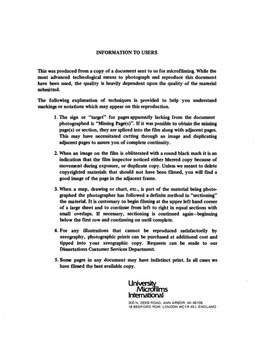| dc.contributor.author | Suarez, Omero, | en_US |
| dc.date.accessioned | 2013-08-16T12:28:19Z | |
| dc.date.available | 2013-08-16T12:28:19Z | |
| dc.date.issued | 1981 | en_US |
| dc.identifier.uri | https://hdl.handle.net/11244/4842 | |
| dc.description.abstract | The nature of the conclusions suggest that further research on cultural problems and lack of integration into the university community would be fruitful in expanding and understanding of persistence among American Indian students. | en_US |
| dc.description.abstract | The principal research question of this study is: In what ways do American Indian students at the University of Oklahoma who are successful in completing coursework differ from those who are less successful (and eventually dropout)? | en_US |
| dc.description.abstract | The statistical analysis consists of two steps. In the first step, bivariate correlations were computed. In the second step, components of the model were examined in an integrated series of regression solutions. The analysis of the bivariate correlation matrix can be summarized by stating that: (a) American Indian students arriving at the University of Oklahoma campus in 1975 who developed higher feelings of integration into the University community were those having fathers of higher educational attainment and having lower attachment to Indian culture; (b) American Indian students arriving in 1975 who persisted were those having higher A.C.T. scores, higher G.P.A.'s in high school, higher family incomes, parents of higher educational attainment, lower attachment to Indian culture, and high feelings of integration into the University community. | en_US |
| dc.description.abstract | The research model for this study focuses on the effects of a group of five antecedent variables on the dependent variable, persistence, and has provisions for influence by an intervening variable. The five antecedent variables are: (1) scholastic aptitude; (2) family income; (3) familial educational level; (4) physical Indianness; (5) attachment to Indian culture. In addition to these five variables there is an intervening variable, integration into the University community, and a dependent variable, persistence in completing coursework. | en_US |
| dc.description.abstract | The findings of the study suggest that those American Indian students who persisted for eight semesters had high grade point averages in high school, had high A.C.T. composite scores, had fathers with high educational attainment, had less attachment to Indian culture and most of all were well integrated into the university community. | en_US |
| dc.description.abstract | This is an ex-post facto descriptive study which examines the entire cohort of American Indian students enrolled in the University of Oklahoma as freshmen in the Fall of 1975. Data are collected on these students for each semester of their collegiate careers, from matriculation to graduation or termination of the university experience. | en_US |
| dc.description.abstract | The findings in the multiple regression table identify three variables that contribute to persistence at the University of Oklahoma; high school grade point average, A.C.T. composite score, and integration into the University community. Each of these have independent significant effects upon persistence. They are the key variables in the model of persistence. Father's educational level and attachment to Indian culture are the two key variables in accounting for who becomes integrated into the University community. | en_US |
| dc.format.extent | viii, 109 leaves : | en_US |
| dc.subject | Education, Administration. | en_US |
| dc.title | Persistence of American Indian students at a comprehensive state university. | en_US |
| dc.type | Thesis | en_US |
| dc.thesis.degree | Ph.D. | en_US |
| dc.thesis.degreeDiscipline | Jeannine Rainbolt College of Education | en_US |
| dc.note | Source: Dissertation Abstracts International, Volume: 42-01, Section: A, page: 0047. | en_US |
| ou.identifier | (UMI)AAI8113250 | en_US |
| ou.group | Jeannine Rainbolt College of Education | |
